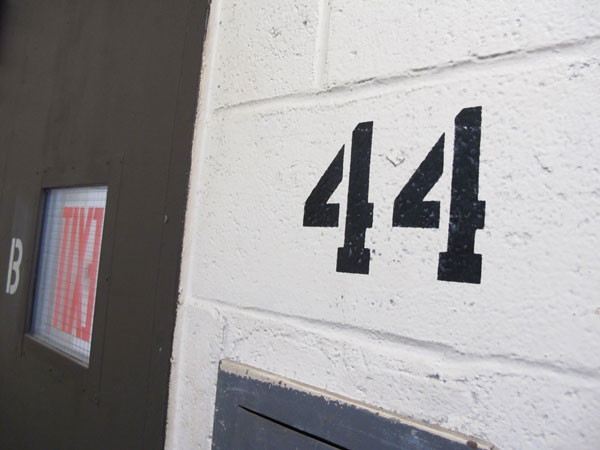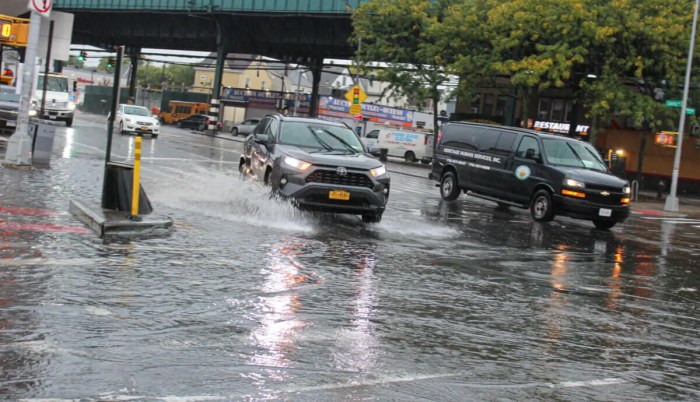
BY ZI HEN LIM | The perk of living on the top floor of Chinatown’s tallest building is that you get unobstructed views of most of Manhattan to the north.
But that perk turns into one big problem when Hurricane-turned-Superstorm Sandy hits and you lose power and water — and use of the elevator.
“My mum blames my grandfather for picking the highest floor,” said Amora Meas, 15, a tenth grader at the High School for Math, Science and Engineering at City College.
With no electricity to run the elevators after around 9 p.m. Monday night, Oct. 29, as the storm hit, residents of the 44-floor housing co-op, Confucius Plaza, on Bowery in Chinatown had to take the stairs to reach the ground floor for water and food, and to charge up their phones at a van set up by Assembly Speaker Sheldon Silver.
But many living in the building are old — some have lived here since it was built in 1975 — or have mobility problems. It’s impossible for them to use the stairs, so they stayed home where the TVs didn’t work and their cell phones received at best patchy reception.
Living on the 44th floor made things doubly hard.
“Oh, 44 flights of stairs, it’s killing me,” said graphic designer Joe Chan, 49, who was walking with a limp on Sat., Nov. 3. He had used the stairs twice: once on Tuesday to get water, and again on Wednesday when he went out to get batteries and food. “My legs are still sore,” he said.
Water supply was the biggest challenge. Water could not be pumped up to the apartments because power was out. As water ran low, alarm bells started ringing.
“I had my bathtub and all my pots filled. I didn’t think it would be that long,” said Sandie Leung, 38. “But one day became two. Two became three. We didn’t have enough water and we needed to go get some — from downstairs.”
Leung had 10 people in her house, including her six children, and her grandmother and uncle, who were visiting from Hong Kong. Water usage was unusually high.
“Ten people using the toilet and not flushing it is disgusting,” she said. “We flushed after every couple of times we used it, but that still added up to at least 10 times a day.”
And each flush used far more water than Leung had expected.
“I thought one 32-ounce Ajax detergent bottle was enough,” she said. “But then it needed two of them, and it still wouldn’t flush. I was thinking, ‘Are you kidding me? I’m wasting so much water!’” she said, exasperated. “So I started using the plunger, and I was like, ‘Go, go already!’”
The family sent four people — Leung and her three eldest children, ages 12 to 17 — down the pitch-dark stairwell each time to collect 10 gallons of water.
The stairs were illuminated only by people’s flashlights and the faint daylight that streamed in from the hallways through the exit doors on each floor, propped open by newspapers or scraps of cardboard.
Only one or two residents used the flashlight apps on their smartphones. Most could not afford to do this because the app takes up a lot of power and meant that they have to go back down very soon to charge the phone up again –— not something you want to do often unless you’re training for a vertical marathon.
People waved their flashlights — up-down or left-right — as they neared a corner, to signal to anyone on the other side of the oncoming traffic.
“The first time we went down to get water, I was dying,” Leung recalled. “I had no breath left in me. I was cursing the storm. I had to rest once every five flights of stairs. I told my kids, ‘Go ahead, go without me.’”
It was also stuffy inside, partly from the absence of windows and also from the sheer number of people shuffling up and down, except at the exits where there was at least some ventilation from the hallways.
“But my kids were very encouraging,” she said. “They said, ‘No man left behind! We’ll wait here, catch your breath first!’”
The stairwell was noisy, the echo amplifying the chatter. Like Leung, many took rests at the exits, bending forward hands on hips to catch their breath.
But traffic began thinning out from the 20th floor onward, and by the 30th floor, there was almost no one using the stairs.
“Once I made it up to the 40th floor, I’m like, ‘Oh my God, I can do this! Four more flights!’ It becomes an achievement, although it took me an hour,” Leung said. “After the first time, it became easier. We started going down twice a day, then three times. And we discovered we could use our backpacks to carry the water, so that our hands are freed to hold onto the railings and pull ourselves up. We timed ourselves: It took us half an hour.”
It took this reporter, a 24-year-old male and regular participant of vertical marathons, seven minutes to cover all 607 steps. But that was without carrying the water, and even then the sensation of burning thigh muscles was apparent.
“In fact, my oldest daughter only took 18 minutes to go down and come back up, with water,” Leung beamed with pride.
Meanwhile, residents who could not leave their apartments had to ration their water and food supplies.
“I limit myself to drinking two pints of water a day, sometimes a bit more,” said D. Y. Chang, professor of East Asian cultures at New York University. “The police were remarkable, going up and down, getting to all floors. They gave me four bottles of water on Wednesday. The young volunteers also gave me a bottle on Thursday.”
Chang, who lives alone, only ate fruits for breakfast and canned food, like beans, sausages or sardines, for dinner.
“I don’t really eat lunch, and this helps stretch out my food supply,” he said. “A couple of my neighbors also shared some of their hot meals and uneaten military meal-packs before they had to leave the building. This helped to extend my supplies.”
Her next-door neighbor, Wong, who declined to give her first name, flushed the toilet with recycled water that she saved from washing.
“Even then, the water in my bathtub is already running low,” said the retiree, who lives with her husband.
Many said they had not had a shower since Mon., Oct. 29.
“I use rubbing alcohol like body wipes,” said Chang.
Besides worrying about water, there was nothing much to do. Most residents read or listened to the radio to kill time.
Wong said she used the time to meditate.
“But I also feel kind of cooped up. I like to go outside, but I’m worried I can’t get back upstairs,” she said. “Sometimes I entertain myself by looking out of the window. I can see the north side of the city. When it gets dark, it’s pitch black below 34th St., except for the police cars and the traffic.”
At the other end of the hallway, Wii Kuen Chan, 87, who lives with her husband, ambled around the house with her walker, since she couldn’t go downstairs.
“At night, we just sit in the dark,” said Chan. “Sometimes we turn on the small battery-operated lamp, but the batteries can go flat in one night.”
Chang, who walks with a cane, had been trying to grade papers.
“I also listen to the radio for news, but I have to turn it off to save the batteries,” she said. “Other than that, it’s just waiting, waiting and waiting.”
At slightly past 7 p.m. Fri., Nov. 2, Chang was going about her routine listening to the news. Then she turned toward the window.
Her clock radio had come back on.
“Hallelujah,” Chang said.
Meanwhile, her neighbor Sandie Leung had just made her trek up the 44 flights of stairs an hour before, and was preparing the flashlights and little lamps as usual.
Then light suddenly shot into her house from the hallway through her wide-open main door.
“My first reaction was, ‘Oh my God, the lights are on,’” Leung recalled. “And then it was, ‘I should’ve waited downstairs!’”
“I looked out of my window and it wasn’t as though you had things going on all at once. It was incremental,” Chang explained. “One store here, a building there, one traffic light, and then a couple of streetlights. They were flickering on.”
There was a huge sense of relief that life could finally return to normalcy, although residents were cautious, especially about using the newly reactivated elevators.
“My daughters still rather walk down the stairs that night,” said Leung “They didn’t want to risk it.”
But by Saturday morning, the building’s four elevators were so busy that residents had to wait up to 10 minutes for one to arrive.
“I mailed a couple of bills this morning, and I have to do laundry later,” Chang said. “It’s nice to have the elevators back.”
Joe Chan returned to his apartment around noon Sat., Nov. 3, for the first time since he left two days earlier to stay over at a friend’s.
“The first thing is to clean out all the spoiled food from the freezer,” he said, listing his tasks. “Then wash the bathroom, flush the toilet a few times. It probably smells like sewer in there now.”
For others, the priority was just to relish the simple pleasures that had been so out of reach the previous week.
“The heater. We can finally turn it on. It’s so cold,” said Wii Kuen Chan. “Ah, and take a shower.”

















